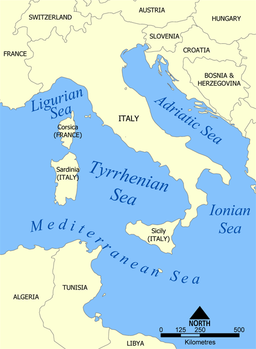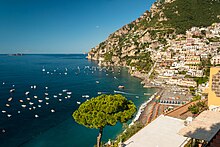| Tyrrhenian Sea | |
|---|---|
 Tyrrhenian Sea Tyrrhenian Sea | |
| Location | Mediterranean Sea |
| Coordinates | 40°N 12°E / 40°N 12°E / 40; 12 |
| Type | Sea |
| Etymology | From the ancient people of Tyrrhenians |
| Basin countries | Italy, France |
| Surface area | 275,000 km (106,200 sq mi) |
| Average depth | 2,000 m (6,562 ft) |
| Max. depth | 3,785 m (12,418 ft) |
The Tyrrhenian Sea (/tɪˈriːniən, -ˈreɪ-/, tih-REE-nee-ən ,-RAY-; Italian: Mar Tirreno [mar tirˈrɛːno] or [-ˈreː-]) is part of the Mediterranean Sea off the western coast of Italy. It is named for the Tyrrhenian people identified with the Etruscans of Italy.
Geography
The sea is bounded by the islands of Corsica and Sardinia (to the west), the Italian Peninsula (regions of Tuscany, Lazio, Campania, Basilicata, and Calabria) to the north and east, and the island of Sicily (to the south). The Tyrrhenian Sea also includes a number of smaller islands like Capri, Elba, Ischia, and Ustica.


The maximum depth of the sea is 3,785 metres (12,418 ft).
The Tyrrhenian Sea is situated near where the African and Eurasian Plates meet; therefore mountain chains and active volcanoes, such as Mount Marsili, are found in its depths. The eight Aeolian Islands and Ustica are located in the southern part of the sea, north of Sicily.
Extent
The International Hydrographic Organization defines the limits of the Tyrrhenian Sea as follows:
- In the Strait of Messina: A line joining the North extreme of Cape Paci (15°42′E) with the East extreme of the Island of Sicily, Cape Peloro (38°16′N).
- On the Southwest: A line running from Cape Lilibeo (West extreme of Sicily) to the South extreme of Cape Teulada (8°38′E) in Sardinia.
- In the Strait of Bonifacio: A line joining the West extreme of Cape Testa (41°14′N) in Sardinia with the Southwest extreme of Cape Feno (41°23′N) in Corsica.
- On the North: A line joining Cape Corse (Cape Grosso, 9°23′E) in Corsica, with Tinetto Island (44°01′N 9°51′E / 44.017°N 9.850°E / 44.017; 9.850) and thence through Tino and Palmaria islands to San Pietro Point (44°03′N 9°50′E / 44.050°N 9.833°E / 44.050; 9.833) on the coast of Italy.
Exits
There are four exits from the Tyrrhenian Sea (north to south):
| Exit | Location | Width | Connected Sea |
|---|---|---|---|
| Corsica Channel | between Tuscany and Corsica 42°50′N 9°45′E / 42.833°N 9.750°E / 42.833; 9.750 | about 80 kilometres (50 mi) | Ligurian Sea |
| Strait of Bonifacio | between Corsica and Sardinia | 11 kilometres (6.8 mi) | Mediterranean Sea (proper) |
| no name | between Sardinia and Sicily | about 290 kilometres (180 mi) | Mediterranean Sea (proper) |
| Strait of Messina | between Sicily and Calabria on the toe of Italy | 3 kilometres (1.9 mi) | Ionian Sea |
Basins
The Tyrrhenian Basin is divided into two basins (or plains), the Vavilov plain and the Marsili plain. They are separated by the undersea ridge known as the Issel Bridge, after Arturo Issel.
Geology
The Tyrrhenian Sea is a back-arc basin that formed due to the rollback of the Calabrian slab towards South-East during the Neogene. Episodes of fast and slow trench retreat formed first the Vavilov basin and, then, the Marsili basin. Submarine volcanoes and the active volcano Mount Stromboli formed because trench retreat produces extension in the overriding plate allowing the mantle to rise below the surface and partially melt. The magmatism here is also affected by the fluids released from the slab.
Name
Its name derives from the Greek name for the Etruscans, first mentioned by Hesiod in the 8th century BC who described them as residing in central Italy alongside the Latins. The Etruscans lived along the coast of modern Tuscany, Latium and Campania, and referred to the water as the "Sea of the Etruscans".
Islands

Islands of the Tyrrhenian Sea include:
- Corsica
- Sardinia
- Sicily
- Tuscan Archipelago
- Ischia
- Procida
- Capri
- Ustica
- Aeolian Islands (including Lipari and Stromboli)
- Pontine Islands including Ponza
Ports
The main ports of the Tyrrhenian Sea in Italy are: Naples, Palermo, Civitavecchia (Rome), Salerno, Trapani, and Gioia Tauro. There is also Bastia, located in Corsica.
Note that even though the phrase "port of Rome" is frequently used, there is in fact no port in Rome. Instead, the "port of Rome" refers to the maritime facilities at Civitavecchia, some 68 km (42 miles) to the northwest of Rome.
Giglio Porto is a small island port in this area. It rose to prominence, when the Costa Concordia ran aground near the coast of Giglio and sank. The ship was later refloated and towed to Genoa for scrapping.
Winds
In Greek mythology, it is believed that the cliffs above the Tyrrhenian Sea housed the four winds kept by Aeolus. The winds are the Mistral from the Rhône valley, the Libeccio from the southwest, and the Sirocco and Ostro from the south.
Image gallery
-
 Monte Argentario
Monte Argentario
-
Pizzo
-
 Zambrone
Zambrone
-
 Parghelia
Parghelia
-
 Ponza
Ponza
-
 Capo Vaticano
Capo Vaticano
-
 Scilla
Scilla
-
 Tindari
Tindari
-
 Cefalù
Cefalù
-
 Palermo
Palermo
-
 Castellammare del Golfo
Castellammare del Golfo
-
Capo Miseno
-
 Terracina
Terracina
-
Terme Vigliatore
Notes
- French: Mer Tyrrhénienne [mɛʁ tiʁenjɛn] Latin: Tyrrhēnum mare, Sardinian: Mare Tirrenu, Corsican: Mari Tirrenu, Sicilian: Mari Tirrenu, Neapolitan: Mare Tirreno
References
- Longman, J.C. (2008). Longman Pronunciation Dictionary (3 ed.). Pearson Education ESL. ISBN 978-1405881173.
- The Editors of Encyclopaedia Britannica. "Tyrrhenian Sea". In Chisholm, Hugh (ed.). Encyclopedia Britannica. Cambridge University Press. Retrieved July 18, 2017.
- "Tyrrhenian Sea - Map & Details". World Atlas. Retrieved July 18, 2017.
- Limits of Oceans and Seas (PDF). Vol. 172 (3rd ed.). 1953. p. 17. Bibcode:1953Natur.172R.484.. doi:10.1038/172484b0. S2CID 36029611. Retrieved May 2, 2020.
{{cite book}}:|work=ignored (help) - ^ Sartori, Renzo (2003). "The Tyrrhenian back-arc basin and subduction of the Ionian lithosphere" (PDF). Episodes. 26 (3). University of Bologna: 217–221. doi:10.18814/epiiugs/2003/v26i3/011. Archived from the original (PDF) on December 19, 2008.
- Faccenna, Claudio; Funiciello, Francesca; Giardini, Domenico; Lucente, Pio (2001). "Episodic back-arc extension during restricted mantle convection in the Central Mediterranean". Earth and Planetary Science Letters. 187 (1–2): 105–116. Bibcode:2001E&PSL.187..105F. doi:10.1016/s0012-821x(01)00280-1. ISSN 0012-821X.
- Hesiod, Theogony 1015.
- Barker, Graeme; Rasmussen, Tom (2000). The Etruscans. The Peoples of Europe. Oxford: Blackwell Publishing. p. 44. ISBN 978-0-631-22038-1.
- Turfa, Jean MacIntosh (2017). "The Etruscans". In Farney, Gary D.; Bradley, Gary (eds.). The Peoples of Ancient Italy. Berlin: De Gruyter. pp. 637–672. doi:10.1515/9781614513001. ISBN 978-1-61451-520-3.
- De Grummond, Nancy T. (2014). "Ethnicity and the Etruscans". In McInerney, Jeremy (ed.). A Companion to Ethnicity in the Ancient Mediterranean. Chichester, UK: John Wiley & Sons, Inc. pp. 405–422. doi:10.1002/9781118834312. ISBN 9781444337341.
- Shipley, Lucy (2017). "Where is home?". The Etruscans: Lost Civilizations. London: Reaktion Books. pp. 28–46. ISBN 9781780238623.
- "Map of Tyrrhenian Sea - Tyrrhenian Sea Map, History Facts, Tyrrhenian Sea Location - World Atlas". www.worldatlas.com. Retrieved 20 March 2018.
- "Civitavecchia (Port of Rome) | Rome for Visitors". europeforvisitors.com. Retrieved 2024-03-28.
- "Costa Concordia comes home to die". The Telegraph. 2014-07-27. Retrieved 2024-03-27.
| Capri | |
|---|---|
| History | |
| Geography | |
| Culture | |
| Archaeological sites | |
| Notable landmarks | |
| Churches |
|
| Villas | |
| Related articles | |